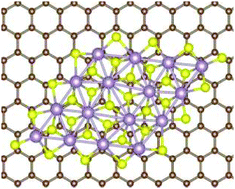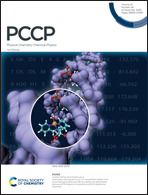Ab initio insights into the stabilization and binding mechanisms of MoS2 nanoflakes supported on graphene†
Abstract
An atomistic understanding of transition-metal dichalcogenide (TMD) nanoflakes supported on graphene (Gr) plays an important role in the tuning of the physicochemical properties of two-dimensional (2D) materials; however, our current atom-level understanding of 2D-TMD nanoflakes on Gr is far from satisfactory. Thus, we report a density functional theory investigation into the stabilization and binding mechanisms of (MoS2)n/Gr, where n = 1, 4, 6, 9, 12 and 16. We found an evolution of the (MoS2)n…Gr interactions from covalent and hybridization contributions for smaller nanoflakes (n = 1, 4) to vdW interactions for larger (MoS2)n nanoflakes (n ≥ 6); however, the coupling of the (MoS2)n and Gr electronic states for n = 1 and 4 is not intense enough to change the Dirac cones at the Gr monolayer. On average, the 1T′- and 2H-(MoS2)n nanoflakes bind with similar adsorption/interaction energies with Gr, and hence the (MoS2)n…Gr interactions do not change the high energetic preference of the 1T′- structures, which can be explained by the stabilizing role of the S-terminated edges in the 1T′-(MoS2)n in contrast with the destabilizing role of the edges in the 2H-(MoS2)n nanoflakes.



 Please wait while we load your content...
Please wait while we load your content...